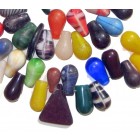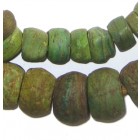
Bohemian, or “Czech” Trade Beads refer to a variety of glass beads produced in Bohemia (now Czechoslovakia) during the 19th and early 20th Century, primarily for use by European merchants during trade missions to Africa, Asia and North America. Czech Trade Beads encompass a wide range of bead formats, ranging from bulbous Mali Wedding Beads and oval Colodonte Beads to faceted, radioactive Vaseline Beads.
Bohemia has a long and fascinating history of glass production, believed to date back to the times of Roman occupation in 400 A.D. Records show there were a number of small factories producing glass beads for rosaries in Bohemia around the 12th Century, however, it wasn’t until the 1500s that these cottage industry crafters began to expand to cities such as Jablonec and Reichenburg.
Glass bead production reached its peak in Bohemia during the 19th Century, and is largely attributed to the ‘bead researchers’ who

Large Mali Wedding Beads
traveled across Europe surveying merchants about the kind of beads most popular among African and North American tribes. Armed with this information, they returned to Bohemia with sketches of prototypes for factory owners. The industrial age also marked a turning point for bead production. New machines and techniques were introduced, allowing for greater control over the uniformity and quality of beads, as well as the speed of production. While Venice set the benchmark for beads of intricate beauty, Bohemia flourished by mass producing relatively plain glass trade beads to order.
Bohemia’s bead-making industry continued to thrive until well into the 1920′s until a series of historic events – namely the Great Depression and World War II – forced the closure of many bead factories in Jablonec. It was during this time that many of the beads produced in the 1900s began to realize considerable value on the Western market. Today, both Mali Wedding Beads and Colodonte Beads are highly collectible; some strands fetching in the region of $200-$300!
References:
The History of Czech Glass, Harlequin Beads.
White Heart Beads (also referred to as “Cornaline D’aleppo“, or “Hudson’s Bay Beads”) were a type of Venetian Trade Bead produced in Venice, Italy, between 1805 and 1900. While highly collectible, these two-tone beads are considerably plainer compared to other sought after trade beads of the time, such as Millefiori Beads, with an off-white or light yellow core enveloped by a skin of scarlet, orange or dark red glass. Historical findings suggest the brilliant red of some White Heart Beads was achieved by adding gold oxide to the glass.

Red White Heart Beads (Cornaline D’Aleppo)
White Heart Beads were traded extensively throughout Africa and North America in the 19th Century, however, the name “Cornaline D’Aleppo” is believed to derive from the old trading town, Aleppo, in Syria. Being a popular stop-off for caravanning merchants en route to the Middle East from the Mediterranean, the town became a thriving marketplace, and an important center for trade between nomadic African tribespeople and Europeans. “Cornaline”, the old French word for “carnelian”, suggests the beads could have been produced as imitations to fool African tribes.
Venetian White Heart Beads tend to be round or oval in shape, however, there is evidence to suggest both the French and Czechs produced similar beads in the 19th Century in a wide range of shapes and sizes. Although similar in aesthetics to White Hearts, Green Heart Beads usually have a green or grayish core.
‘Russian Blues’ were a popular type of Trade Bead produced in old Bohemia (now the Czech Republic) during the 19th Century. Their popularity among African and Amerindian tribes stems from the fact that, unlike most Trade Beads which were typically oval or tubular, these particular Trade Beads were faceted like precious gems. Most beads comprised eighteen or twenty-four facets, however larger, elongated beads generally had twelve. These particular Bohemian beads were commonly produced in a limited spectrum of dark to mid blue, and ranged in size from 5-12mm. Early 20th Century beads were produced in green and lighter blue shades.
The moniker “Russian Blues” derives from the fact these old Czech beads were brought in vast quantities to the US and Canada by Russian fur traders in the 19th Century. Following the discovery of Alaska by Vitrus Bering in 1741, Russian merchants began exporting large quantities of glass beads, copper kettles and tools in exchange for sea otter pelts. Captain James Cook set sail for America in 1778 in an attempt to find out more about the endeavors of the Russians, and it is allegedly his reports which prompted both English and European merchants to follow in their footsteps. By the mid 19th Century, European merchants had established numerous trade networks in African and America, and Russian Blues played a central role in the exploitation of the regions for commercial gain.
Early Russian Blues were created by a process known as “drawing” – similar to that used for Venetian Chevron Beads. First, a bubble would be formed at the center of a glass tube by pulling it whilst hot. This would form the perforation hole. A second puntile (a long, hollow metal tube) would then be attached to the tube at the opposite end, and the glass pulled until the desired width was achieved. The molten glass would be cut whilst still hot, and after cooling, the sides ground by hand to achieve facets at specific angles. Later Russian Blues were cast in molds, however, were almost always hand finished in the same manner.
References:
Faceted Bohemian Beads, Exhibit 11. Picard Beads
Russian Blue Trade Beads, History. Active Artist Network
King Beads are a type wound Venetian trade bead produced throughout the 19th and 20th Century in Murano, Venice, primarily for trade with Africa and America. They are distinguishable from striped Chevron Beads by their bicone shape, and the fact they do not feature a rosetta around the perforation hole. African legend tells that King Beads got their name because of their popularity among tribal chiefs up until the 1970s.
The earliest known examples of King Beads feature on numerous sample cards donated by Moses Lewin Levin to the British Museum around 1865. Early 20th Century King Beads (dated 1920) also feature within a collection of sample cards donated by Sick and Co; a German company who, until 1964, were one of Europe’s largest exporters of Trade Beads to Africa.
King Beads are one of the earliest types of biconical Trade Bead to have been produced by the marvering method. A marver is a long, thin rod made of copper, around which heated glass is slowly wound. A paddle or steel flipper is used to shape the glass whilst hot, and trails of colored glass then applied to create the distinctive polychromatic stripes. Nineteenth century King Beads were commonly produced in black, green and yellow varieties, with trailed horizontal stripes in two to three colors.
References:
King Beads, About African Beads
French Cross Beads (also known as “Bodoum Beads” in parts of West Africa) were a popular type of wound Venetian Trade Bead produced in limited quantities throughout the 19th Century. Their intended purpose was use as a medium of exchange or currency in new territories, such as Africa and South America, although they also found their way to parts of Asia in the early 20th Century.

Yellow and White French Cross Beads
So called because of the distinctive polychrome cross designs on their outer skins, French Cross Beads realized considerable value among tribes along the Ivory Coast and central Mali. They were produced in both yellow and white – the latter being far more scarce than the colored varieties. While most beads featured a single cross design in one or two colors on either side of the bead, others were decorated with trailed and cross-hatched designs. French Cross Beads were produced in a variety of sizes ranging from a tiny 5mm to just over 12mm.
The production of Bodoum Beads involved an ancient bead-making technique known as winding or marvering. Glass is first heated in a furnace to make it ductile, then whilst still hot, is slowly wound around a copper mandrel coated in clay or borum nitride. This would form the bead release, which made it easier to ‘release’ the beads later on. While the glass was still hot, it would be manipulated with a flat-sided paddle to achieve the spherical shape. Finally, thinner strips of hot glass would be applied to create the cross design.
Much like old Venetian King Beads, French Crosses were only produced in limited number, and were therefore considered particularly valuable by tribes in Africa owing to their scarcity. They were commonly exchanged for valuable elements, such as gold and silver, as well as heavy animal pelts and palm oil. Today, French Cross Beads are still considered quite valuable, and can fetch between $50 and $300 at online auction.
References:
Wound Glass Beads – Wikipedia
French Cross Beads - About African Beads

Green Hebron Beads
Hebron Beads (sometimes referred to as Kano Beads) are a form of glass Trade Bead which originate from the Holy city of Hebron in Palestine. The city is rather better known as the final resting place of the patriarchs and matriarchs of the Jewish, Muslim and Christian faiths, however, also has a long and fascinating history of glass-making which dates back to 63 BCE. These early glass beads were blown spheres of round glass, simply decorated with evil eye designs to ward off malevolent spirits. Hebron Beads are typically donut-shaped with a far courser finish.
The earliest known beads produced in Hebron for trade were manufactured during the 18th Century. British explorer William George Brown references two different sizes of bead – Hershe and Munjir – produced in the region in his journal of 1799, with further observations detailing their course texture and rustic finish. Their eroded aesthetic derives from the fact that they are made with salts from the Dead Sea, and sand from the outlying village of Bani Na’im.
As trade networks developed between Africa, Palestine and Egypt in the early 1800s, Hebron’s glass-makers began producing beads exclusively for trade in foreign lands. They were particularly well received by the Igbo and Yoruba tribes of Kano, Nigeria, both of whom consider large, heavy beads to be indicative of wealth and social status. The Yoruba, however, noticed that the rough glass beads did not sit uniformly when strung upon a raffia, and so ground down the sides of the beads themselves using flattened stones. Early historians were originally of the impression the beads were produced by the Yoruba – hence the name “Kano Beads”.